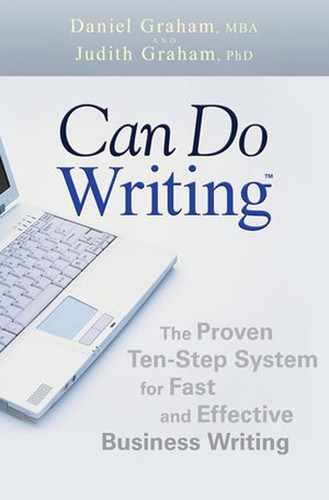You finished analyzing, writing, and editing your document for information and style. You still need to check for word choice, grammar, punctuation, and mechanics. Although Can Do Writing ends with editing, we leave you with a few helpful hints.
Because of your systematic editing, you have a head start on correctness. When writing your draft, you used who does what and what does what sentences. Therefore, your sentences are grammatically simple and less likely to have punctuation errors. Your edit for coherence already improved your document's consistency and mechanics. Your edits for clarity and economy solved many word choice and grammar errors.
You need a couple of resources to help you check for correctness. Buy a new dictionary every ten years. Words change—annoying perhaps, but true. Everyone in your office needs to work from the same dictionary.
Use a style manual appropriate to your work. Style manuals get into fine details, such as when to capitalize words. You have free access to the Government Printing Office Style Guide on the Internet. No style guide can answer every question. Therefore, if you create many documents, you need to supplement your chosen style guide with a style sheet. When you write for publication, ask for the publisher's style sheet, and use the publisher's chosen style manual.
Use your software tools, but don't trust them. Grammar checkers make mistakes. Autocorrect features cause embarrassments.
The Internet is a warehouse of information with on-line dictionaries, style guides, and tutorials on grammar and punctuation—plus search engines to help you find answers.
You know your subject matter. You have a proven system for writing. Now make good things happen for yourself and for your readers.
Have confidence in your documents. The Can Do Writing system works every time for every kind of nonfiction document. You can analyze any writing problem no matter how complex. You can organize your thoughts in the most persuasive manner to get the results you want because your readers get the results they want. One side benefit of using this system is that you become a better analyst—a clearer thinker!
Have confidence in yourself. By working systematically, you master the techniques. Each document becomes an opportunity to practice—to improve. Because you edit systematically, you quickly incorporate—hardwire, in effect—the techniques into your language. You naturally compose your drafts without passive voice, tense shifts, subjunctive mood, ambiguous pronouns, and other clarity problems. You naturally compose your draft using fewer useless words, and you naturally compose at a better level of readability. In just a few months, depending on how much you write, you notice that your drafts are cleaner.
Enjoy the efficiency of the system. You can better plan your time, and you can write 20 to 40 percent faster. Also, by using the purpose statement and outline, you can catch errors quickly and avoid painful rewrites.
Finally, take pride in the results of your work—not just the document, but your work. As a manager, take pride in your good decision made possible by your written policy. As a sales representative, take pride in your satisfied customers—the result of your proposal letters. As an engineer, take pride in your new technology, made possible by your design documents.
You can do it!
